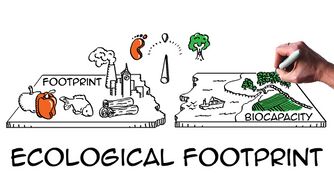Diferencia entre revisiones de «Ecological footprint»
(Página creada con «It is the impact of human consumption demand. It is the relation between the natural resources that we have and the natural resources that we use. Humans consume natural resources in excess. They generate waste and produce a negative impact on the environment. miniaturadeimagen|334x334px Each city, state or nation´s biocapacity represents the productivity of its natural capital<ref>Renewable and non- renewable resources</ref>.…») |
Sin resumen de edición |
||
| (No se muestran 3 ediciones intermedias del mismo usuario) | |||
| Línea 1: | Línea 1: | ||
It is the impact of human consumption demand. It is the relation between the natural resources that we have and the natural resources that we use. | It is the impact of human consumption demand. It is the relation between the natural resources that we have and the natural resources that we use. [[Archivo:ECOLOGICAL FOOTPRINT.jpg|miniaturadeimagen|334x334px]]This method determines how dependent humans are on natural resources. This is a meassure that indicates how many resources from the environment are requiered to support a specific way of life or business. | ||
Humans consume natural resources in excess. They generate waste and produce a negative impact on the environment. | Humans consume natural resources in excess. They generate waste and produce a negative impact on the environment. | ||
Each city, state or nation´s biocapacity represents the productivity of its natural capital<ref>Renewable and non- renewable resources</ref>. These areas can also serve to absorb the waste we generate, especially our carbon emissions from burning fossil fuels<ref>'''Fossil fuels''' are made from decomposing plants and animals. These fuels are found in Earth´s crust and contain carbon and hydrogen, which can be burned for energy. Examples of fossil fuels are coal, natural gas and petroleum.</ref>. | Each city, state or nation´s biocapacity represents the productivity of its natural capital<ref>Renewable and non- renewable resources</ref>. These areas can also serve to absorb the waste we generate, especially our carbon emissions from burning fossil fuels<ref>'''Fossil fuels''' are made from decomposing plants and animals. These fuels are found in Earth´s crust and contain carbon and hydrogen, which can be burned for energy. Examples of fossil fuels are coal, natural gas and petroleum.</ref>. | ||
Each city, state or nation´s ecological footprint can be compared to its biocapacity, or that of the world. | Each city, state or nation´s ecological footprint can be compared to its biocapacity, or that of the world. | ||
If a population´s ecological footprint exceeds the region´s biocapacity, that region runs a ''biocapacity deficit.'' Its demand for | If a population´s ecological footprint exceeds the region´s biocapacity, that region runs a ''biocapacity deficit.'' Its demand for the goods and services that its land and seas can provide- fruit, vegetables, meat, cotton, among others- exceeds what the region´s ecosystems can generate. | ||
The countries with the largest ecological footprints are the USA and China because people consume a lot of natural resources. They consume food, energy, paper, plastic, transport, television, among others. As a consequence, they generate too much waste. They do not reduce, reuse or recycle enough. | The countries with the largest ecological footprints are the USA and China because people consume a lot of natural resources. They consume food, energy, paper, plastic, transport, television, among others. As a consequence, they generate too much waste. They do not reduce, reuse or recycle enough. | ||
=== National footprint and Biocapacity Accounts === | === National footprint and Biocapacity Accounts === | ||
There is an organization called '''''FoDaFo'''''- Footprint Data Foundation- York university, Toronto | There is an organization called '''''FoDaFo'''''- Footprint Data Foundation- York university, Toronto and Global Footprint Network work together on research and studies. | ||
York university also provides the academic support. The orgaization´s main purpose is to inform people and to provide the reliability. | |||
[[Archivo:FoDaFo.png|centro|miniaturadeimagen|480x480px|[https://www.fodafo.org/ FoDaFo]]] | |||
==== Your personal ecological footprint ==== | |||
Are you conscious about your lifestyle and the amount of natural resources that you use in your daily life? | |||
There are some websites that allow people to do a survey and calculate their personal footprints. They include questions related to the animal based products they consume, the type of houses and the energy they consume, among others. | |||
https://www.footprintcalculator.org/home/en | |||
<references /> | |||
[[Categoría:Green Technology]] | |||
Revisión actual - 14:04 13 jul 2023
It is the impact of human consumption demand. It is the relation between the natural resources that we have and the natural resources that we use.
This method determines how dependent humans are on natural resources. This is a meassure that indicates how many resources from the environment are requiered to support a specific way of life or business.
Humans consume natural resources in excess. They generate waste and produce a negative impact on the environment.
Each city, state or nation´s biocapacity represents the productivity of its natural capital[1]. These areas can also serve to absorb the waste we generate, especially our carbon emissions from burning fossil fuels[2].
Each city, state or nation´s ecological footprint can be compared to its biocapacity, or that of the world.
If a population´s ecological footprint exceeds the region´s biocapacity, that region runs a biocapacity deficit. Its demand for the goods and services that its land and seas can provide- fruit, vegetables, meat, cotton, among others- exceeds what the region´s ecosystems can generate.
The countries with the largest ecological footprints are the USA and China because people consume a lot of natural resources. They consume food, energy, paper, plastic, transport, television, among others. As a consequence, they generate too much waste. They do not reduce, reuse or recycle enough.
National footprint and Biocapacity Accounts
There is an organization called FoDaFo- Footprint Data Foundation- York university, Toronto and Global Footprint Network work together on research and studies.
York university also provides the academic support. The orgaization´s main purpose is to inform people and to provide the reliability.
Your personal ecological footprint
Are you conscious about your lifestyle and the amount of natural resources that you use in your daily life?
There are some websites that allow people to do a survey and calculate their personal footprints. They include questions related to the animal based products they consume, the type of houses and the energy they consume, among others.
https://www.footprintcalculator.org/home/en

